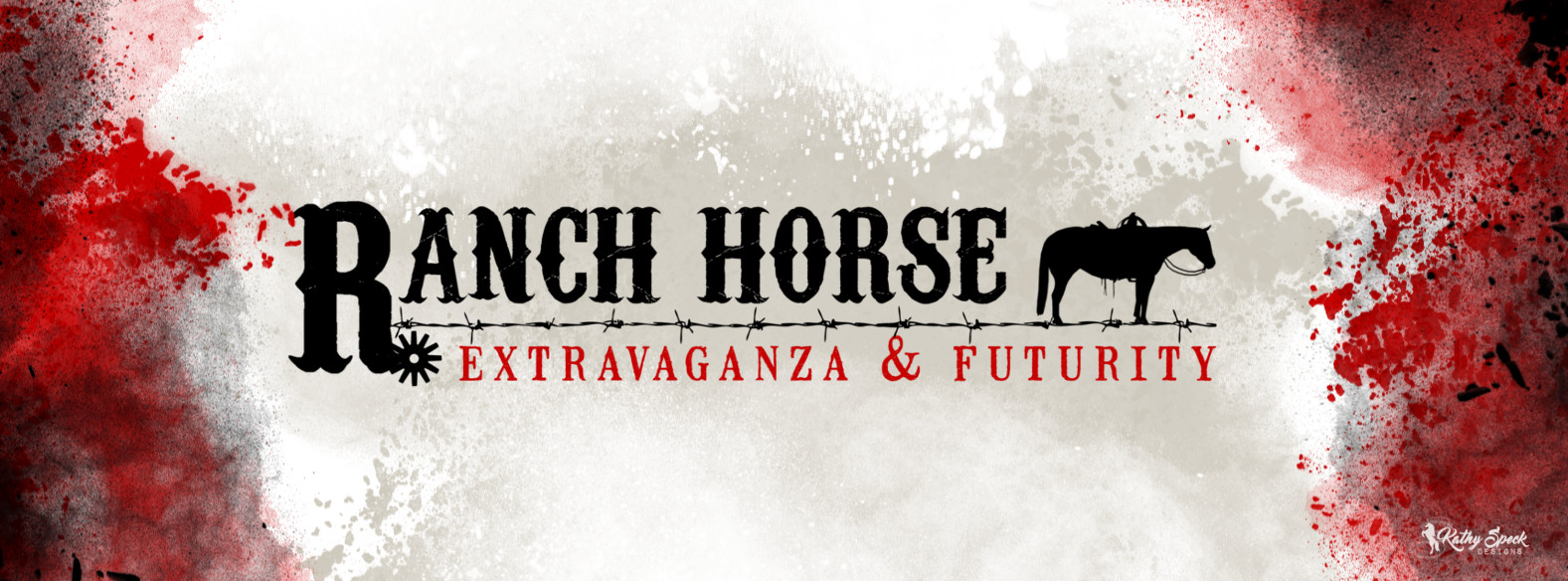Classes and Futurity Rules
Offspring Eligibility
● Offspring sired by enrolled stallions whose age at the time of the show
are yearlings, 2 or 3 years old are eligible to show.
Futurity Prize Money
● Payout will consist of 93% of stallion enrollment plus class entry fees
used as futurity prize money.
● Up to 10 placings will be paid out.
● Current horse owner, as shown on registration papers or indicated on entry form, will receive 90% of the payback, the stallion owner/agent or designated payee (outside of owner) will receive 10%. ● Each year the Stallion Enrollment money will be divided out over the three age groups with yearlings having 25%, 2 year olds 35% and 3 year olds 40%.
Class Payout:
Payout scale
10 places 25%, 18%, 13%, 10%, 8.5%, 7%, 6%, 5%, 4%, and 3.5%
9 Places 26%, 19%, 13%, 10%, 9%, 8%, 6%, 5% and 4%
8 places 26%, 22%, 14%, 10%, 9%, 8%, 6% and 5%
7 Places 28%, 22%, 17%, 10%, 9%, 8% and 6%
6 places 32%, 22%, 19%, 10%, 9% and 8%
5 places 34%, 27%, 20%, 10% and 9%
4 places 40%, 30%, 20% and 10%
3 Places 45%, 35% and 20%
2 Places 60% and 40%
1 Place 100%
Futurity Champion
● A Futurity champion will be named in each age division based on the highest money earned.
● In the case of a tie for the high money earning futurity champion, the winner will be determined by the highest point total, calculated as follows: Open and Non-Pro exhibitors accumulate points on one horse for combined score/points in each age division to determine a high point
horse from their respective age group. Points are calculated by the number of entries shown in each class. ie: 45 in a class, 1st place gets 45 points, 2nd gets 44, 3rd gets 43 and so on. If needed, the highest number of points calculated under the tiebreaker judge will be the final
determination.
● In the case of a tie in a class, a tiebreaker judge will be used to determine the final placings but the money for the tied places will be added together and split equally. The tiebreaker judge will be announced/posted prior to the start of the show. Exhibition
● All judges' scores will count towards the final placings.
● Equipment regulations relevant to the futurity classes will be guided by the following AQHA rules: Section SHW300-equipment, Section SHW305- western equipment, SHW306- western optional equipment
through SHW307.9- western prohibited equipment.
● A complete photocopy of the eligible horse’s registration papers (if applicable) must be provided to the show secretary.
● Verification of papers may be made with the appropriate registry prior to prize money being issued.
● Any horse and/or exhibitor that is disqualified is ineligible for prize money & awards.
● All paybacks will be determined using the number of horses entered in that class.
● A partial refund may be considered if a horse becomes severely injured, disabled, or deceased, but only if requested a minimum of two weeks prior to the start of the show. Documentation from a veterinarian stating the severity of the debilitating injury or illness is required. Stall, drug, obstacle and entry fees may be refunded; however, office fees & cattle charges will not be refunded. Management will have the final decision. Illness, accidents or other incidents concerning people will not be eligible for refund.
● Proof of non-pro (amateur) status from a breed association or a signed declaration stating the exhibitor is a non-pro is required for exhibition in non-pro classes.
● In-sufficient funds will be charged a $40 fee and any earned monies held until payment is confirmed.
Classes
● Yearling Ranch Conformation-open
● Yearling Ranch Prospects Fundamentals- open
● 2 year-old Ideal Ranch Horse- open
● 2 year-old Ideal Ranch Horse- non-pro
● 2 year old Ranch Trail- open
● 2 year-old Ranch Trail- non-pro ● 3 year-old Ideal Ranch Horse- open
● 3 year-old Ideal Ranch Horse- non-pro
● 3 year old Ranch Trail- open
● 3 year old Ranch Trail-non-pro
● 3 year old Ranch Riding- open
● 3 year old Ranch Riding - non-pro
Yearling Ranch Conformation - The purpose of ranch conformation is to select stock type selecting well-mannered individuals in the order of their resemblance to the breed ideal and that are the most positive combination of balance, structural correctness, and movement with appropriate breed and sex characteristics and adequate muscling. The ideal conformation horse should have a natural ranch horse appearance from head to tail. All horses in each division will be shown together as one class: stallions, mares and geldings. All horses whose registration certificates are marked with a parrot mouth,
cryptorchid are ineligible to compete in the ranch horse conformation class. All stallions shall be examined to confirm that they have two visible testicles. All
stallions and mares shall be examined for parrot mouth. If examination reveals that a horse has parrot mouth or is cryptorchid, such horse should be excused from the ring prior to final placing by the judge regardless of whether the parrot mouth or cryptorchid condition is marked on the horse’s registration certificate.
Horses are to be shown in a good working halter: rope, braided, nylon or leather. Any horse shown in the ranch horse conformation class may not be shown with an allowed lip cord, however a lead shank with an attached chain may be used under the chin or over the nose. As the horse approaches, the judge will step to the right to enable the horse to trot straight to a cone placed 50 feet away. At the cone, the horse will continue trotting, turn to the left and trot toward the left wall or fence of the arena. After trotting, horses will be lined up head to tail for individual inspection by the judge. The judge shall
inspect each horse from both sides, front and rear and place the horses in order of preference.
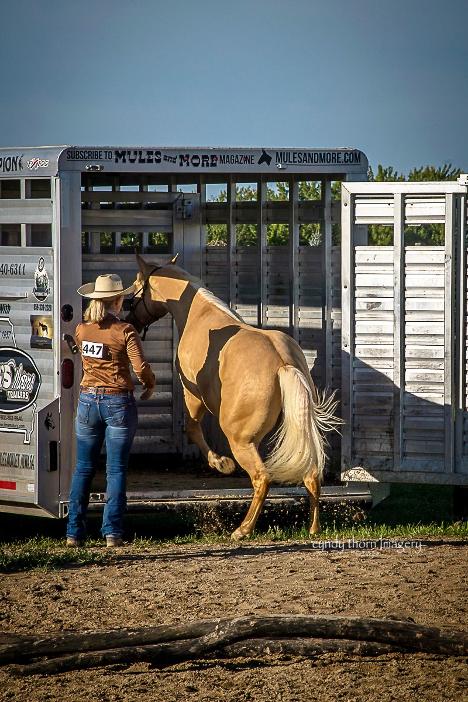
This class will be judged on the performance of the horse over the obstacles, with emphasis on manners, response to the exhibitor, and on how the partnership of the horse/exhibitor works together. Credit will be given to the
horse that negotiates the obstacles with style, expression, attitude and some degree of speed, providing carefulness is not sacrificed. Horses shall be penalized for any unnecessary delay while approaching the
obstacles. The horse/exhibitor team should negotiate each obstacle with calmness and patience, moving safely through each obstacle. Horses should show awareness, be attentive and not spook, shy or spin. The horse should not
stumble. A minimum of (6) obstacles (maximum of twelve (12) obstacles) will be used. The course shall be returned to its original design after each horse has worked.
1. Obstacles should be representative of challenges found on the trail or simulate what may be experienced by horse/rider on a ranch.
2. The course must be posted at least one (1) hour before the scheduled time of class.
3. Obstacles on this list are a foundation, however the management reserves the right to add obstacles not listed within the working confines of which the class is based in. This class may include the following obstacles and/or tasks but not limited to:
a. Walk over bridge
b. Walk over logs/brush pile
c. Tie to a fence
d. While tied, push hip right & left, pick up feet
e. Back in chute
f. Serpentine through obstacles
g. Load & unload from trailer
h. Round pen- An exhibitor will have 40 seconds to free lunge to demonstrate walk/trot/lope, catch & walk out through the gate.
i. Rub with saddle blanket
Equipment: A good working halter- rope, braided, nylon or leather halter. No chains or shanks allowed on lead line. Scoring:
1. Scoring will be on the basis of 0-infinity, with 70 denoting an average performance. Each obstacle will receive an obstacle score that should be added or subtracted from 70 and is subject to a penalty that should be subtracted.
2. Each obstacle will be scored on the following basis, racing from plus 3 to minus 3.
a. 3- Excellent
b. 2- Very Good
c. 1- Good
d. 0- Correct
e. -1 - Poor
f. -2 - Very Poor
g. -3- Extremely poor
3. Obstacle scores are to be determined and assessed independently of penalty points.
4. Credit will be given to those yearlings negotiating the obstacles cleanly, smoothly, and alertly with style in prompt response to the handler’s cues while exhibiting a willing attitude and expression.
Penalties should be assessed per occurrence as follows:
1. One (1) Point Penalty
a. Incorrect or break of gait at a walk or jog for two (2) strides or less.
b. 2 strides or less out of lead in the round pen.
c. Pushing against the exhibitor while maneuvering serpentine or circles.
d. Bucking or playing in the round pen but able to be corrected or stopped.
2. Three (3) Point Penalty
a. Incorrect or break of gait at a walk or jog for more than two (2) strides.
b. Stepping outside of the confines of, falling or jumping off or out of an obstacle with (1) foot once the foot has entered the obstacle; including missing (1) element of an obstacle on a line of travel with one (1) foot.
c. Jerking foot away. d. Setting back on halter.
e. Tripping/stumbling through obstacle (s) with no recognition of where feet are being placed.
f. Walking away or pulling away while catching to halter each instance.
g. Bucking or playing in the round pen but unable to be corrected or stopped.
h. Over two strides out of lead in the round pen.
3. Five (5) Point Penalty
a. Dropping the object required to be carried on course.
b. First or second cumulative refusal, balk, or evading an obstacle by shying or backing.
c. Stepping outside the confines of, falling or jumping off or out of an obstacle with more than (1) foot once the foot has entered the obstacle; including missing one (1) element of an obstacle on a line of travel with more than (1) foot.
d. Blatant disobedience (including kicking out, striking or
continuously circling the exhibitor) in or out of the round pen.
4. Zero (0) total score for course (disqualification)
a. Performing the obstacles other than in specified order.
b. No attempt to perform an obstacle.
c. Equipment failure that delays completion of pattern.
d. Failure to enter, exit or work obstacle in any manner other than described, including overturns of more than one quarter (¼) turn.
e. Working outside the designated boundary marker of the arena or course area.
f. Failure to demonstrate correct gait between obstacles as
designated.
g. Animal gets loose from the exhibitor.
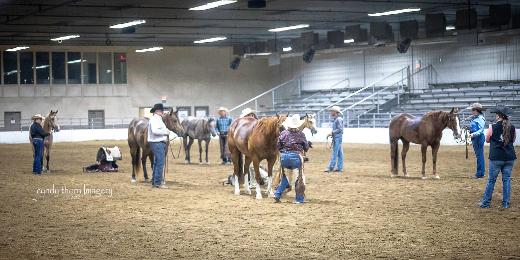
Exhibitors may be asked to demonstrate walk, extended walk, trot, extended trot, lope and extended lope. Exhibitors will be asked to enter the class to complete the riding portion of the class first, then asked to come into the center, unsaddle the horse and stand for conformation. The combined score will represent the horses final placing using 60% rail and 40% conformation. The essence of this class is to not only view each portion of the class as it is but to also view the horse in its entirety.
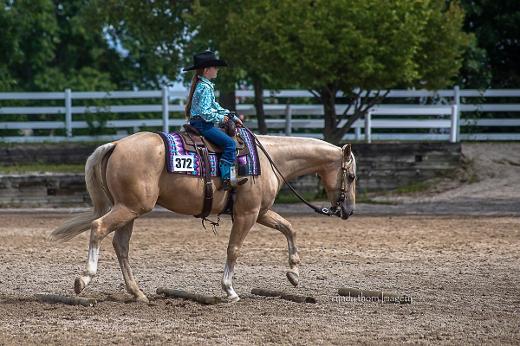
AQHA SHW416. The purpose of the ranch riding class is to measure the ability of the horse to be a pleasure to ride while being used as a means of conveyance from performing one ranch task to another. The horse should reflect the versatility, attitude and movement of a working ranch horse riding outside the confines of an arena. The horse should be well-trained, relaxed, quiet, soft and
cadenced at all gaits. The ideal ranch horse will travel with forward movement and demonstrate an obvious lengthening of stride at extended gaits. The horse can be ridden with light contact or on a relatively loose rein without requiring undue restraint, but not shown on a full drape of reins. The overall manners and responsiveness of the ranch riding horse to make timely transitions in a
smooth and correct manner, as well as the quality of the movement are of primary considerations. The ideal ranch riding horse should have a natural ranch horse appearance from head to tail in each maneuver.
AQHA SHW417.1 Each horse will work individually, performing the required gait maneuvers and a minimum of three optional maneuvers. Horses will be scored on the basis of 0 to 100, with 70 denoting an average performance. Each maneuver will receive a score that should be added or subtracted from 70 and is subject to a penalty that should be subtracted. Each maneuver will be
scored on the following basis, ranging from plus 1 1/2 to minus 1 1/2.: -1 1/2 extremely poor, -1 very poor,-1/2 poor, 0 correct, +1/2 good, + 1 very good, + 1 1/2 excellent. Maneuver scores are to be determined and assessed independently of penalty points. AQHA SHW417.2 One of the 15 approved patterns must be used. AQHA SHW417.3 The overall cadence and performance of the gaits should be as those described in GAITS, (AQHA SHW334 Ranch Riding) with an emphasis on forward movement, free-flowing, and ground covering for all gaits. Transitions should be performed where designated, with smoothness and responsiveness. AQHA SHW417.4 No time limit. AQHA SHW417.5 The use of natural logs is encouraged. AQHA SHW417.6 Posting at the extended trot is acceptable. AQHA SHW417.7 Touching or holding the saddle horn is acceptable. AQHA SHW418. Ranch Riding Apparel and Equipment AQHA SHW418.1 No hoof polish. AQHA SHW418.2 No braided or banded manes/tails or tail extensions. AQHA SHW418.3 Trimming inside ears is discouraged. AQHA SHW418.4 Trimming bridle path is allowed, also trimming of fetlocks or excessive (long) facial hair. AQHA SHW418.5 Equipment with silver should not count over a good working outfit. Excessive silver on bridles and saddles is discouraged. AQHA SHW418.6 It is suggested competitors use a breast collar and a rear cinch. AQHA SHW418.7 When exhibiting in a snaffle bit or hackamore, an exhibitor may switch between two hands and one hand on the reins at any time.
AQHA SHW419. Ranch Riding Penalties. A contestant shall be penalized each time the following occur: AQHA SHW419.1 One (1) point penalties Too slow (per gait) Over-bridled (per maneuver) Out of frame (per maneuver) Break of gait at walk or trot for 2 strides or less. AQHA SHW419.2 Three (3) point penalties Break of gait at walk or trot for more than 2 strides. Break of gait at lope, except when correcting an incorrect lead Wrong lead or out of lead. Draped reins (per maneuver). Out of lead or cross-cantering more than two strides when changing leads. Trotting more than three strides when making a simple lead change. Severe disturbance of any obstacle. AQHA SHW419.3 Five (5) point penalties Blatant disobedience (kick, bite, buck, rear, etc.) for each refusal. AQHA SHW419.4 Ten (10) point penalty 5 Unnatural ranch horse appearance (Horse’s tail is obvious and consistently carried in an unnatural manner in every maneuver). AQHA SHW419.5 (OP) Placed below horses performing all maneuvers Eliminates or adds maneuver. Incomplete maneuver. Repeated blatant disobedience. Use of two hands (except junior and level 1 horses shown in a snaffle bit/hackamore), more than one finger between split reins or any fingers between romal reins (except in the two rein).
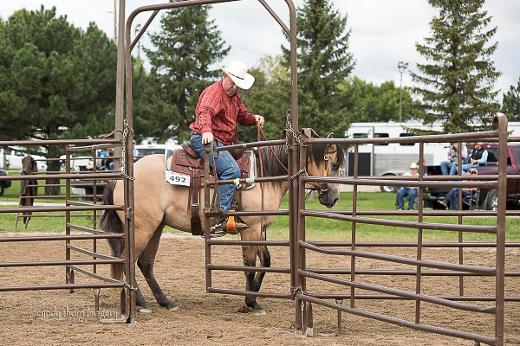
Ranch trail patterns will not be posted until the day before the show; a list of obstacles will be provided that may be used in the class. AQHA SHW561. The ranch trail class should test the horse’s ability to cope with situations encountered while being ridden through a pattern of obstacles generally found during the course of everyday ranch work. The horse/rider team is judged on the correctness, efficiency and pattern accuracy with which
the obstacles are negotiated and the attitude and mannerisms exhibited by the horse. Judging emphasis is on identifying the well broke, responsive and well mannered horse which can correctly navigate and negotiate the course. The ideal ranch trail horse should have a natural ranch horse appearance from head
to tail in each maneuver. AQHA SHW561.2 The ranch trail course will include no less than six and no more than nine obstacles. It is mandatory that the horse be asked to walk, trot and lope during the course. Walk can be part of obstacle score or be scored with the approaching obstacle. Trot must be at least 35 feet and score with approaching obstacle. Lope must be lead-specific, at least 50 feet and score with approaching obstacle. Care must be exercised to avoid setting up any obstacles that may be hazardous to the horse or rider. AQHA SHW561.3 When setting courses, management will be mindful that the idea is not to trap a horse/rider team or eliminate it by making an obstacle too difficult. All courses and obstacles are to be constructed with safety in mind so as to reduce the risk for accidents. Show committee shall have the option of setting up the trail course to best fit the arena conditions. An outdoor course is recommended if appropriate terrain is available. Each single-performance event can be time consuming, especially with large classes, so it is imperative that time restrictions are placed on this class. The show committee, either through a pilot run or estimation, shall select a course that has a continuous and positive flow that can be negotiated in four minutes or less. AQHA SHW561.4 Judges must walk the course and have the right and duty to alter the course if it is not in keeping with the intent of the class. Judges may remove or change any obstacles they deem unsafe, non-negotiable or unnecessarily difficult. Any time a trail obstacle becomes unsafe during a class, it shall be repaired or removed from the course. If the course cannot be repaired and some horses have completed the course, the score for that obstacle shall be deducted from all previous draws in that class. AQHASHW561.5 The course must be designed using the mandatory obstacles and maneuvers plus optional obstacles. Combining two or more of the obstacles is acceptable. AQHA SHW561.6 PROHIBITED OBSTACLES: Tarps, water obstacles with slick bottoms, PVC pipe used as a jump or walk over, tires, rocking or moving bridges, logs elevated in a manner that permits such to roll in a dangerous manner. AQHA SHW561.7 MANDATORY OBSTACLES AND/OR MANUEVERS. 1. Ride over obstacles on the ground (usually logs). Walk, trot or lope may be used but only one gait is required. Walk-overs: Walk over no more than five logs no more than 10 inches high and spacing between 26 – 30 inches. The formation may be straight, curved, zig- zagged or raised. Trot-overs: Trot over no more than five logs no more than 10 inches high. The space between logs or poles should be36-42 inches. The formation can also be straight, curved, zigzagged or raised. Lope-overs: Lope over no more than five logs no more than 10 inches high. The space between logs should be 6 to 7 feet. The formation can also be straight, curved, zigzagged or raised. 2. Opening, passing through and closing a hinged swinging gate (not a rope gate): Use gate that will not endanger horse or rider and requires minimum side-passing. 3. Ride over wooden bridge: Bridge should be sturdy, safe and negotiated at a walk only. Heavy plywood lying flat on the ground is an acceptable simulation of a bridge. Suggested minimum width shall be 36 inches wide and at least 6 feet long. 4. Backing obstacles: Backing obstacles are to be spaced at a minimum of 28 inches. If elevated, 30 inch spacing is required. Back through and around at least three makers. Back through L, V, U or straight or similarly shaped course which may be elevated no more than 24 inches. 5. Side-pass obstacle: Any object which is safe and of any length may be used to demonstrate responsiveness of the horse to leg signals. Raised side pass obstacles should not exceed 12 inches. 6. Drag an object: Drag may be a complete figure eight and may begin in either direction. The exhibitor must have the rope dallied on the saddle horn (half or full dally) for the duration of the drag. AQHA SHW561.8 OPTIONAL OBSTACLES. Optional obstacles may be 6 used provided the obstacles can be found in everyday ranch work. Optional obstacles from which selections can be made include, but are not limited to: A jump obstacle whose center height is not less than 14 inches high or more that 25 inches high. Holding the saddle horn is permissible for this obstacle. Only live or stuffed animals which would normally be encountered in an outdoor setting may be used but not to be used in an attempt to spook a horse. Carry object from one part of the arena to another. Remove and replace materials from a mailbox. Trot through cones spaced a minimum of 6 feet apart. - Cross natural ditches or ride up embankments. Swing rope or throw rope at a dummy steer head. Step in and out of obstacle. Put on slicker or coat. Stand to mount with mounting block. Walk through water obstacle. Open gate on foot. Pick up feet. Walk through brush. Ground tie. (Hobbles are allowed) - Lead at the trot. AQHA SHW561.9 At show management option the competition trail course may be made available to exhibitors or posted prior to the day of competition. It must be posted at least one hour prior to competition. AQHA SHW561.10 CREDITS AND PENALTIES. All runs begin upon entering the pen and any infractions are subject to penalty at that time (such as two hands on the reins, using either hand to instill fear or praise, etc.). The rider has the(cont’d) option of eliminating any obstacle, however this will result in being “off pattern” (OP) and the horse/rider team may not place above others who have completed the pattern correctly. A judge may ask a horse to pass on an obstacle after three refusals or at any time for safety concerns. AQHA SHW561.11 Credit is given to horse/rider teams who negotiate the obstacles correctly and efficiently. Horses should receive credit for showing attentiveness to obstacles and ability to negotiate through the course when the obstacles warrant it while willingly responding to rider’s cues on more difficult obstacles. Quality of movement and cadence should be considered part of the maneuver score for the obstacle. Penalties are assessed as follows: 1 Point Penalties: Over-bridled (per maneuver); out of frame (per maneuver); each hit, bite or stepping on a log, cone plant or any component of the obstacle; incorrect or break of gait at walk or trot for two (2) strides or less; both front or hind feet in a single-stride slot or space at a walk or trot; skipping over or failing to step into required space; split pole in lope-over; incorrect number of strides, if specified; one to two steps on mount/dismount or ground tie except shifting to balance. 3 Point Penalties: Wrong lead or out of lead, draped reins; break of gait at lope, except when correcting an incorrect lead; break of gait at walk or trot for more than two (2) strides; three to four steps on mount/dismount on ground tie. 5 Point Penalties: Spurring in front of cinch; blatant disobedience; use of either hand to instill fear/praise; knocking over, stepping out of or falling off an obstacle; dropping an object required to be carried; 1st or 2nd cumulative refusal; letting go of gate; five or more steps on mount/ dismount or ground tie. 10 point: Unnatural ranch horse appearance (Horse’s tail is obvious and consistently carried in an unnatural manner in every maneuver) Off-Pattern (OP): Incomplete maneuver; eliminating or adding a maneuver; 3rd refusal; repeated blatant disobedience, and failure to dally and remain dallied during the drag; use of two hands (except junior and level 1 horses shown in a snaffle bit/hackamore), more than one finger between split reins or any fingers between romal reins (except in the two- rein); failure to open and shut gate, or failure to complete gate. Exhibitors cannot place above others who complete the pattern correctly. Disqualification (DQ): Lameness, abuse, leaving working area before pattern is complete, illegal equipment, disrespect or misconduct, improper western attire; fall of horse/rider.
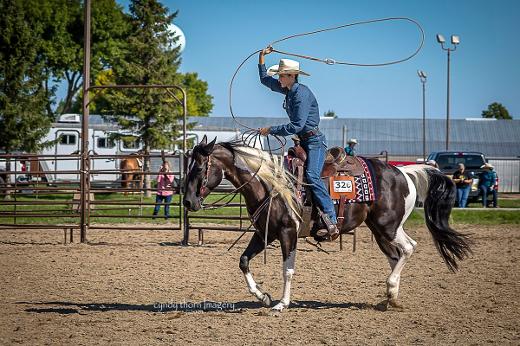
© Copyright Ranch Horse Extravaganza & Futurity
